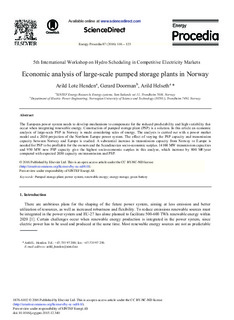| dc.contributor.author | Henden, Arild Lothe | |
| dc.contributor.author | Doorman, Gerard L. | |
| dc.contributor.author | Helseth, Arild | |
| dc.date.accessioned | 2016-02-04T10:47:32Z | |
| dc.date.accessioned | 2016-07-28T11:49:05Z | |
| dc.date.available | 2016-02-04T10:47:32Z | |
| dc.date.available | 2016-07-28T11:49:05Z | |
| dc.date.issued | 2016 | |
| dc.identifier.citation | Energy Procedia 2016, 87:116-123 | |
| dc.identifier.issn | 1876-6102 | |
| dc.identifier.uri | http://hdl.handle.net/11250/2397357 | |
| dc.description | - | |
| dc.description.abstract | The European power system needs to develop mechanisms to compensate for the reduced predictability and high variability that occur when integrating renewable energy. Construction of pumped storage plant (PSP) is a solution. In this article an economic analysis of large-scale PSP in Norway is made considering sales of energy. The analysis is carried out with a power market model and a 2030 projection of the Northern Europe power system. The effect of varying the PSP capacity and transmission capacity between Norway and Europe is studied. A substantial increase in transmission capacity from Norway to Europe is needed for PSP to be profitable for the owners and the Scandinavian socio-economic surplus. 14100 MW transmission capacities and 950 MW new PSP capacity give the highest socio-economic surplus in this analyse, which increase by 800 M€/year compared with expected 2030 capacity on transmission and PSP. | |
| dc.language.iso | eng | |
| dc.title | Economic Analysis of Large-Scale Pumped Storage Plants in Norway | |
| dc.type | Journal article | |
| dc.type | Peer reviewed | |
| dc.date.updated | 2016-02-04T10:47:32Z | |
| dc.identifier.doi | doi:10.1016/j.egypro.2015.12.340 | |
| dc.identifier.cristin | 1331938 | |
